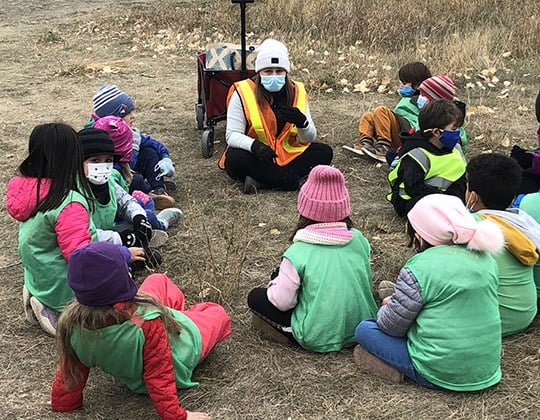 Spending hours outside with a busy group of three- to six-year-olds may sound like a recipe for chaos.
Spending hours outside with a busy group of three- to six-year-olds may sound like a recipe for chaos.
But for teachers and students at Buena Vista School, a morning spent at Gabriel Dumont Park, or their schoolyard, or other locations in the neighbourhood offers lessons in how being outdoors and engaging with nature provides new perspectives and creates learning opportunities that wouldn't be available sitting in a classroom.
"I regularly have students asking to go outside on our 'adventures' as soon as they walk in the door," said Laura Tebay, whose three- and four-year-old prekindergarten students spend the majority of their three-hour morning outside. "The students love exploring both new and familiar places in their community with their peers through whole-group, small-group, and self-directed learning opportunities. Families have connected to share that their child is excited about coming to school because they will be spending so much time outside."
Buena Vista's brand-new, half-day prekindergarten program, along with its alternating day kindergarten classrooms, have a specific focus on experiential and land-based learning. The programs, and their emphasis on exploring the outdoors, have been a hit with teachers, parents, and, most importantly, students.
"Children love to be outside," said kindergarten teacher Lisa Grabinsky Sparks. "However, the students are eager to go outside to learn, not just to play. 'What science are we doing or where are we going?' are the comments instead of 'it's playground time.' They want to learn more about what surrounds them, and they see school as a place to do this."
Certain subject areas are linked to outdoor learning in a very visible way, but simply being outdoors in a constantly changing environment presents authentic, hands-on opportunities that make learning more meaningful for young students. Leaves are gathered, investigated, drawn, and used for purposes that adults can't fathom. Sticks and rocks beg to be counted, pine cones are grouped, and evergreens are compared to trees whose leaves are turning colour and falling.
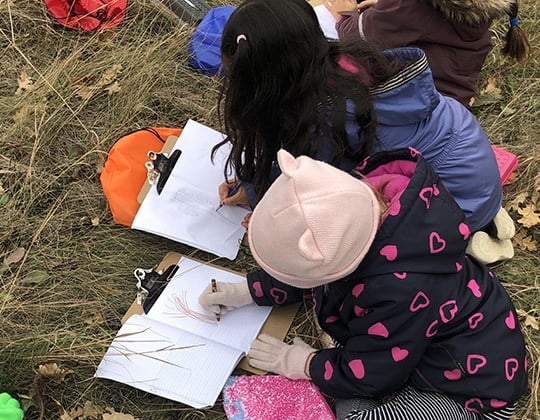 "Writing about a favourite tree in the park has them not only observing seasonal changes, but taking part in writing about a shared experience, which has them more engaged," said Laurie McWillie, who takes her classroom-based Grade 1 students outside for one to two hours each day.
"Writing about a favourite tree in the park has them not only observing seasonal changes, but taking part in writing about a shared experience, which has them more engaged," said Laurie McWillie, who takes her classroom-based Grade 1 students outside for one to two hours each day.
"As a teacher, it is important to have a strong understanding of the curriculum to ensure all the outcomes are being met, but also to be available when learning opportunities present themselves and be able to tie the concepts together."
Learning outdoors is nothing new, but the opportunity for the youngest students to spend a significant part of their learning time outside — in all seasons, and in all kinds of weather — contrasts with the more traditional classroom. Land-based learning is purposeful in both lesson planning and what the students are engaged in, Sparks explained. Even the way in which students interact with the environment is designed with purpose, but also with flexibility that provides space for organic learning opportunities.
All three teachers praise how students have embraced the challenges and experiences involved in spending their school day outside. Even as the weather grows colder, the prekindergarten and kindergarten classes plan to spend as much time as possible outside.
While curricular goals play an important role in what the students do outdoors, the ways in which students build independence, resilience, responsibility, relationships, and confidence is an important component of this approach to learning.
"Children have an innate connection with being in outdoor settings and so their confidence is much greater, and they are willing to take more risks — whether that is standing on an uneven log or talking to a new classmate," Grabinsky Sparks said. "They are able to create their play experiences by moving logs and tires around, something we may not normally 'trust' small children to do. They fall, they get up, they evaluate, and they learn for themselves to try again, change something, or walk away."
Tebay said outdoor learning also challenges students and teachers mentally because it forces them to reflect on what they know about the world around them and ask questions they may never have considered.
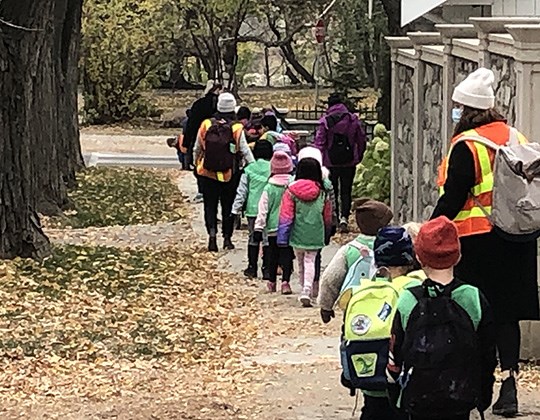 "Students take pride in demonstrating their maturity in exploring and caring for the world around them," she said. "I have been amazed at the different roles students take in their outdoor learning. The students take turns being the leaders and followers in their learning and development and support each other in pursuing challenges and new knowledge. The endless possibilities of the outdoor world allow all students to find confidence and success in some area."
"Students take pride in demonstrating their maturity in exploring and caring for the world around them," she said. "I have been amazed at the different roles students take in their outdoor learning. The students take turns being the leaders and followers in their learning and development and support each other in pursuing challenges and new knowledge. The endless possibilities of the outdoor world allow all students to find confidence and success in some area."
The decision to offer an early learning program with an outdoor focus was immediately embraced by Buena Vista's school community when it was announced in June. The new prekindergarten program filled up quickly and the school has enough kindergarten students enrolled to offer two, alternating day kindergarten programs for the first time in several years.
Parents Parker Halfinger and Gabrielle Neiman said their daughter, Freya, comes home with positive stories about what and how she is learning in kindergarten.
"We are extremely excited for Freya to have the opportunity to be outside and explore the community. We do it as a family, but it is so important she does it in a social setting and an academic way," Halfinger said.
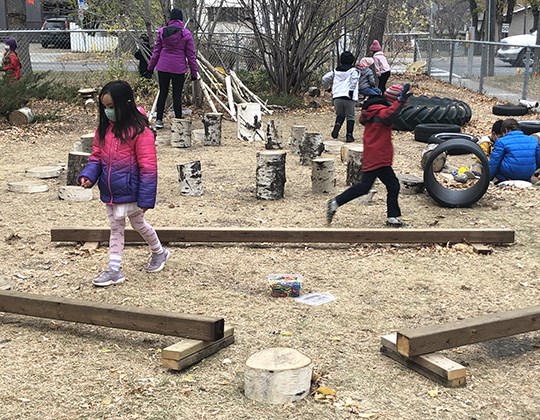 "We checked out the outdoor classroom space within the first weeks of school because we wanted to see what it was like," Neiman added, "and I was so thrilled to see how they had set up the space in the learning area. Even though we are in the middle of a city they can mimic and create that feeling of being on the land. Both of us are firm believers that we need to rebuild that connection to the land and the younger we do it, the better it is. I have a super active kid and she comes home tired."
"We checked out the outdoor classroom space within the first weeks of school because we wanted to see what it was like," Neiman added, "and I was so thrilled to see how they had set up the space in the learning area. Even though we are in the middle of a city they can mimic and create that feeling of being on the land. Both of us are firm believers that we need to rebuild that connection to the land and the younger we do it, the better it is. I have a super active kid and she comes home tired."
One learning opportunity for both students and teachers is the importance of working together as a class and remaining safe. McWillie said her Grade 1 students understand how to be responsible when exploring the world outside of the school, and that provides them with opportunities to explore independently and with more self-direction.
"We spent a lot of time in the first few weeks practicing what it looks like to be safe, what boundaries are and why they are important and how to return to the group quickly and safely when called back to our base camp," she said. "We practice those skills every time we are off the school grounds, and I am always amazed at how well they've got this."
For the teachers, taking learning out of the classroom and into the community has been an energizing challenge. It has encouraged them to find ways to adapt and innovate as they integrate curricular goals into their outdoor adventures.
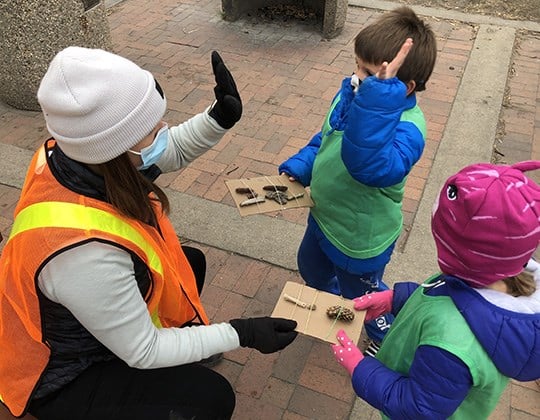 "I've been teaching a long time, and this is reinventing my wheel — and it is fabulous," Grabinsky Sparks said. "I have completely changed the way I look at teaching concepts and how the curriculum outcomes can be achieved. Much of this is depending on the students themselves; they are leading the learning and asking questions they want to know the answers to, and I am linking this to the curriculum."
"I've been teaching a long time, and this is reinventing my wheel — and it is fabulous," Grabinsky Sparks said. "I have completely changed the way I look at teaching concepts and how the curriculum outcomes can be achieved. Much of this is depending on the students themselves; they are leading the learning and asking questions they want to know the answers to, and I am linking this to the curriculum."
The COVID-19 pandemic created new interest in learning outdoors among teachers at all grades and at many schools across the division. Tebay said the benefits of land-based experiences for both students and teachers are obvious.
"I have found students to be more engaged, curious, courageous, and grounded when outside. I am amazed at the conversations we are able to have and the ideas we are able to explore together outside," she said. "(Being in) the natural environment is reminding us that learning happens far beyond the walls of a classroom."